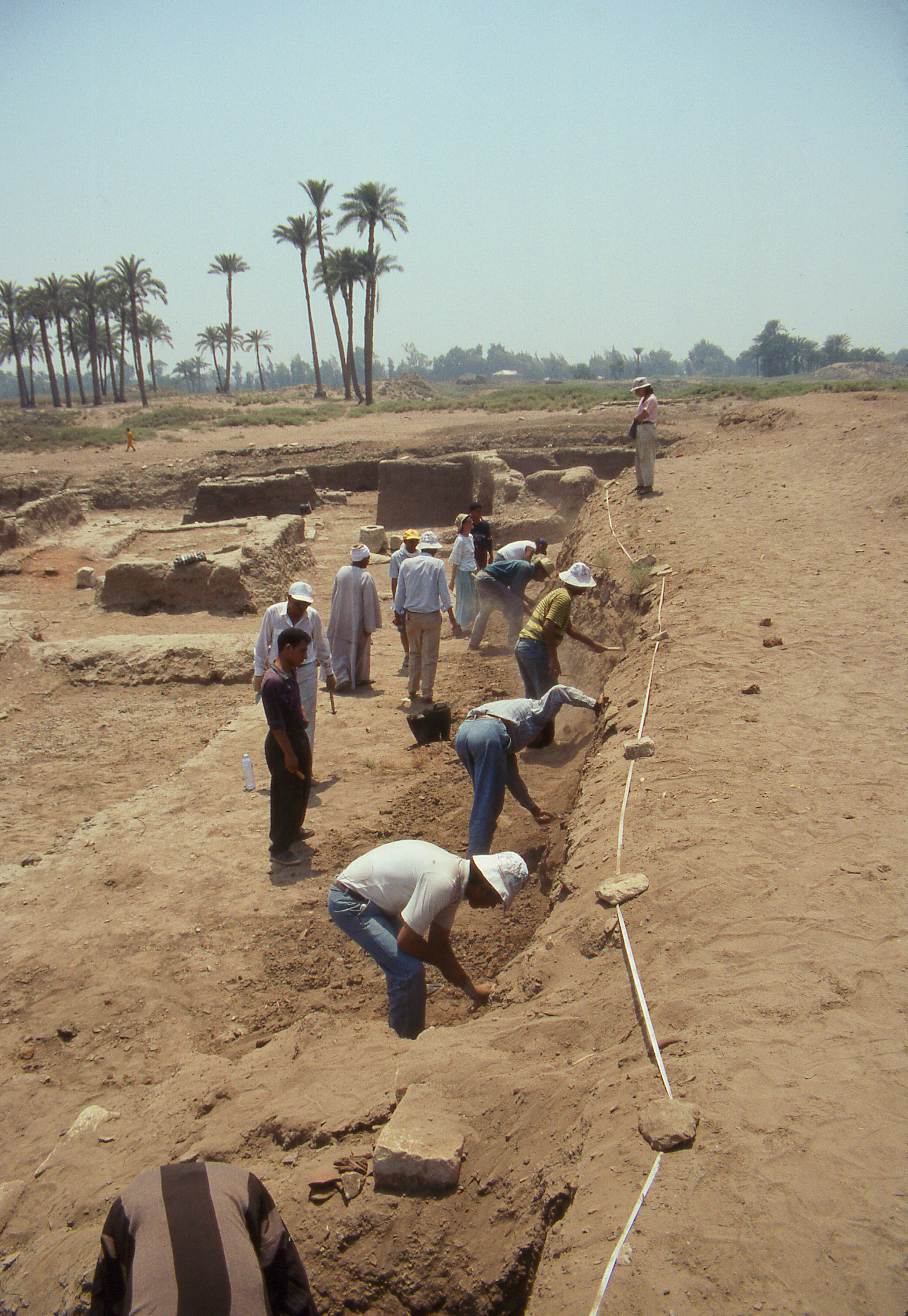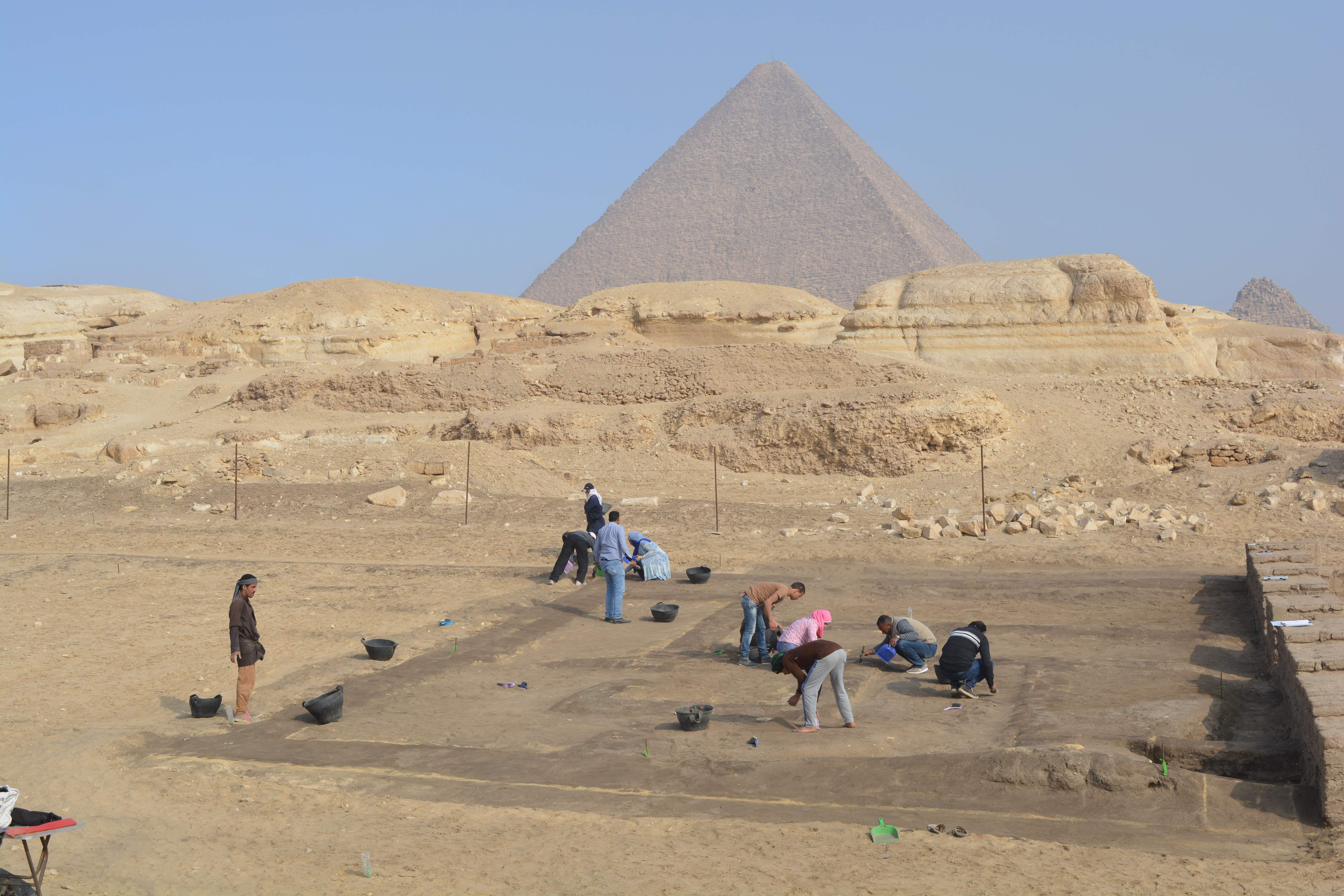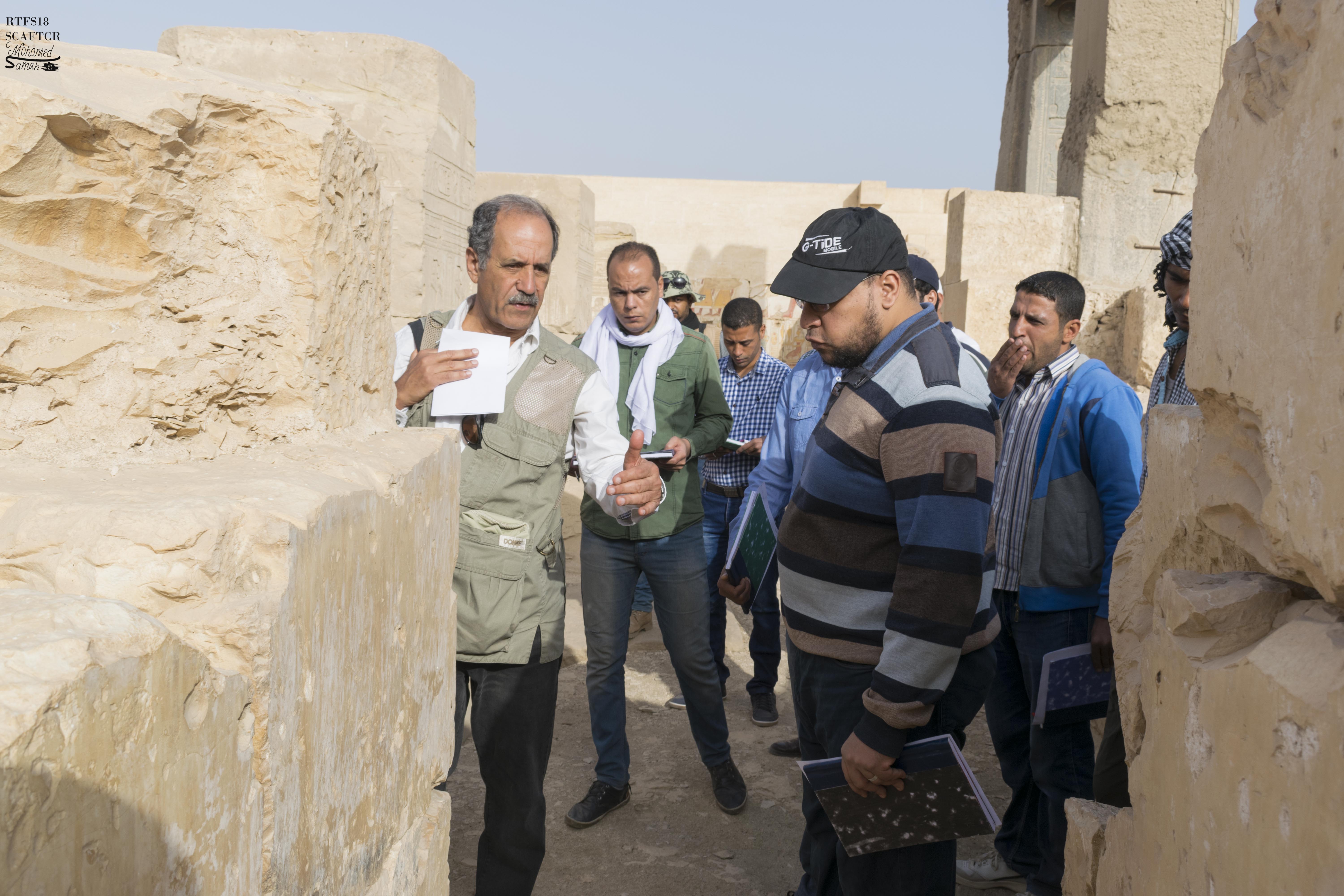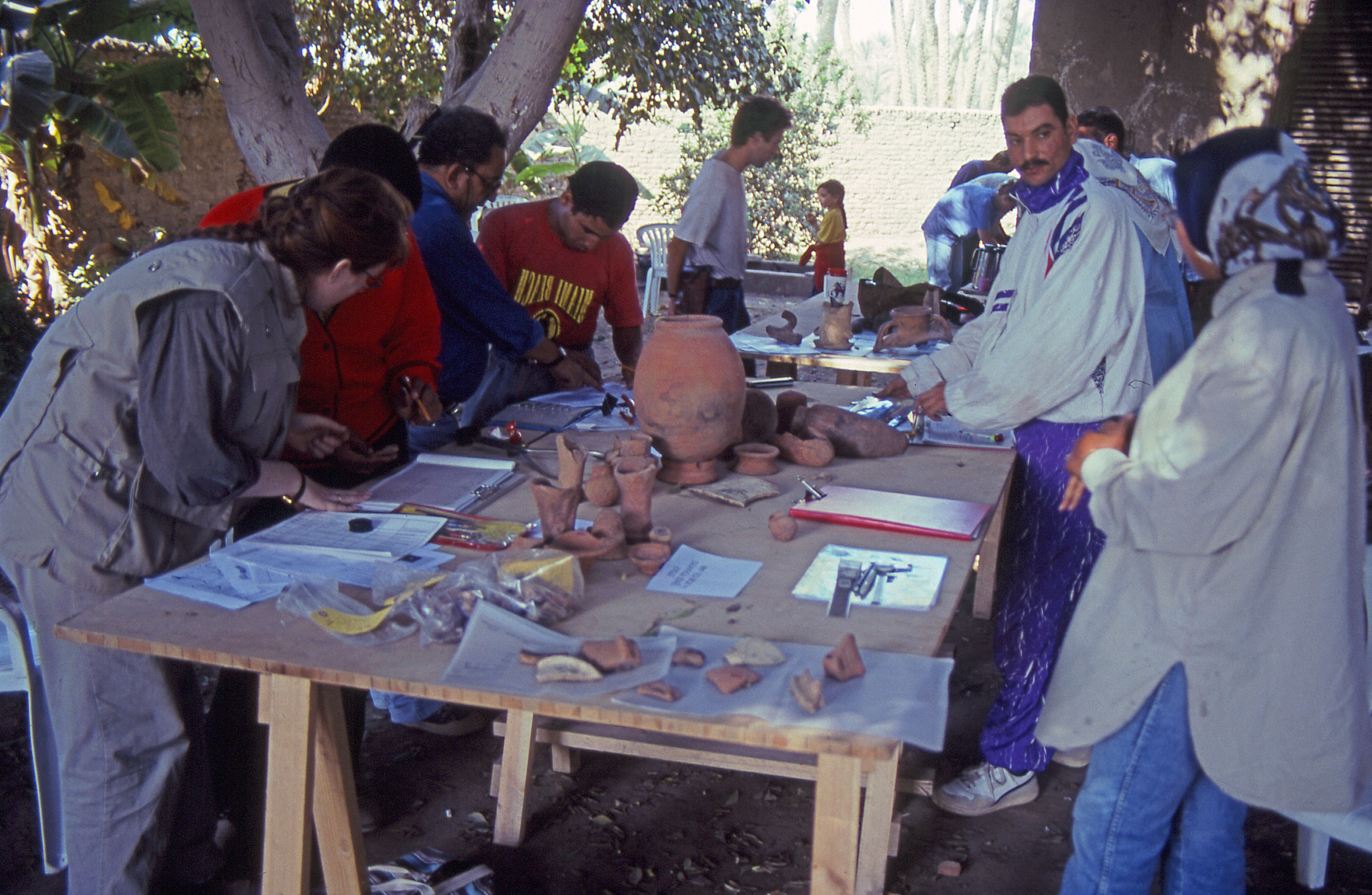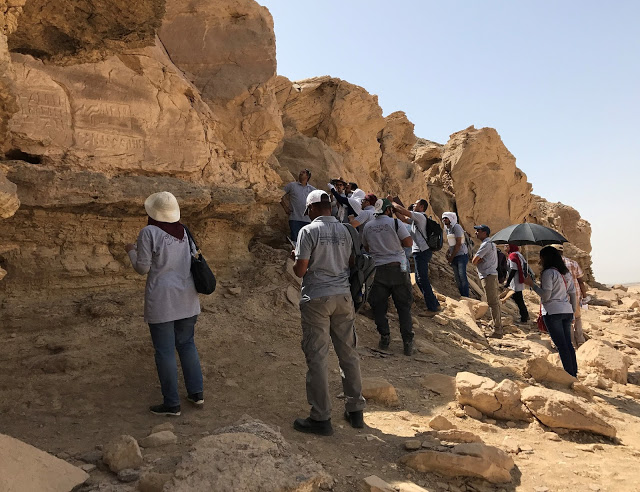Schools of the Trade
Rabee Eissa is the tall, bespectacled personification of the benefits of field schools in Egypt. One of the Ministry of Antiquities’ ubiquitous inspectors at missions across the nation, Eissa studied excavation for two years in ARCE-funded field schools. He was inspired to spend a decade as an instructor for later field school students, earning his M.A. and Ph.D. in archaeology along the way. Today, Eissa continues to teach at field schools and draws on his excavation skills as the director for the Ministry of Antiquities’ dig at the newly discovered temple of Ptolemy II in Beni-Suief.
“A large number of my colleagues and I are using the skills we learned in field schools in our own excavations everywhere across Egypt,” Eissa says. “The field school is very important for the ministry because it creates a new generation of professional archaeologists.”
Eissa’s example is among hundreds that demonstrate how the value of field schools multiplies through scores of excavation and conservation projects. What started simply as an ARCE proposal to help government inspectors understand the details of excavations has helped change the face of Egyptology, lecture by lecture, dig by dig.
Diana Craig Patch, who in 1995 pioneered the first ARCE field school for ministry inspectors, says her idea was to “help break down the boundaries between Westerners and Egyptians in terms of knowledge and the control of that knowledge.” Field schools allowed inspectors “to become much more our colleagues,” says Patch, now the Lila Acheson Wallace curator in charge of Egyptian art at the Metropolitan Museum of Art.
Sameh Iskander, an Egyptian Egyptologist and former ARCE president, considers field schools a landmark step toward a more collaborative era for his profession. “The key is to give back to Egypt after we have received so much over the years,” says Iskander, who directed a 2017 inspector field school at Abydos for New York University, an ARCE research supporting member.
Today, field schools sponsored or funded by ARCE and many other organizations have been refined into what informally might be labeled “field universities,” where advanced courses far beyond a trowel and a brush burnish the knowledge of Egyptian inspectors. Courses – often taught or co-taught by Egyptians – range from ceramics, restoration and epigraphy to digitization, writing and publication. Lectures cover specialties such as osteology, archaeobotany and zooarchaeology.
But the impact of inspector field schools extends beyond curriculum. Field schools have always promoted cooperative learning and teaching, with Egyptians involved at the front of the classroom. The schools also encouraged critical thinking and independent judgment by inspectors, leading to increasing Egyptian contributions. As field schools continued, more graduates became instructors who helped manage schools. The Egyptian government started its own schools in archaeology, conservation and other skills, often taught by former students or instructors at ARCE-sponsored field schools. The result is a new era of partnership and independence for Egyptians and others who study Egypt’s remarkable, seminal contributions to civilization.
EARLY DAYS OF EGYPTOLOGY
Egypt, of course, has experienced many decades of foreign scrutiny of its history, culture and monuments, and those explorations occurred after centuries of war, conquest, colonization and appropriation. Some of this began as long as a millennium ago, or even earlier, when first the Greeks and then the Romans explored and studied the pyramids and the Great Sphinx. Under Ottoman rule from the 1500s, Egypt and its environs were occupied by the British in 1882, who fully withdrew 70 years later. Prior to the British, Napoleon sponsored a series of French explorations that spawned international interest in Egypt and its past. As a result, Western colonialism permeated the early days of modern Egyptology. Scholars and explorers from France, Britain, Germany, Italy, the United States and other nations descended on the pyramids, temples and other enticing remnants of thousands of years of cultural heritage. The result was that non-Egyptians gained more renown in the now international field of Egyptology. A sampling of famous names from this era is decidedly non-Arabic: Carter, Champollion, Petrie, Reisner, Belzoni and Brugsch.
One typical attitude from these Egyptologists was to assume their own scholarly superiority and to consider Egyptians as mostly hired labor. At excavations, local men and teens once known as “basket boys” were hired to haul debris away after it had been examined by Western archeological teams. One exception was the famed multi-generational excavators and foremen from Quft, an area just north of Luxor on the east bank of the Nile that still produces some of Egypt’s best excavators.
Meanwhile, over the centuries, thousands of statues, mummies, pots, coffins and even entire walls or tombs were removed from Egypt. Treasure hunters sold some to make money; others were taken by researchers to their home countries. As an example, the iconic Rosetta Stone, a key to the mystery of hieroglyphs, still rests on an honored perch in the British Museum, 3,600 miles from where one of Napoleon’s soldiers discovered it in the Nile Delta in 1799. A lesser-known example is a large family statue taken sometime in the 19th century from the fifth-dynasty tomb of Rawer at Giza. Today, each member of the five-person family resides in separate pieces in U.S. museums; scholars theorize it was broken apart because the individual pieces would garner more money than if the piece was sold as a single statue. After the creation of the Egyptian Antiquities Service, artifacts were shared between Egypt and the foreign missions that helped uncover them. That policy proved controversial, yet many of these scholarly spoils remain in museums worldwide.
Students studying in the AERA/ARCE 2018 advanced field school excavate at Khentkawes Town in Giza
“Egyptians were to some extent marginalized and provincialized in the study of their own ancient culture,” explains Mark Lehner, another inspector field school innovator and president of the Ancient Egypt Research Associates (AERA). Over his four decades in Egyptology, Lehner saw these attitudes firsthand.
As Egypt regained independence in 1922 and developed economically and academically, it reasserted control over historic sites, known or unexplored. No longer would British, American or French teams simply return for their annual seasons of work. The Egyptian government instead set up a system of controls, permissions and oversight, while also gradually reinstating its own exploration and preservation.
Over time, Egyptians were required to be employed in responsible positions on foreign-led digs, and an increasingly sophisticated system of government inspectors was established to provide on-site monitoring. One goal was to make sure that artifacts remained in Egypt. Especially with the Egyptian population boom after World War II, archaeologists realized they needed to cooperate to excavate, document and protect scores of endangered sites that faced destruction from the tractors and bulldozers of modern agriculture and development – and from a later all-out push for tourism at the nation’s most famous monuments.
Sameh Iskander with field school students in Abydos
Government inspectors relied on formal training and degrees from Cairo University and other institutions, which provided a solid understanding of Egyptian history, language and major historic sites. But these inspectors were neither archaeologists nor anthropologists; they were assigned to oversee dig sites without detailed knowledge of the meticulous techniques needed for excavation, restoration or documentation.
“They became inspectors,” says JJ Shirley, director of the ARCE-funded TT110 Epigraphy and Research Field School (ERFS) in Luxor and managing editor of the Journal of Egyptian History, “but they didn’t know anything about archaeology or epigraphy or pottery or bones or other specialized skills, unless they sought it out themselves. And that’s difficult to do; there was no system in Egypt that provided it in any systematic way.”
Reflecting the attitudes of the past, some foreign missions preferred inspectors who left them alone. Deserved or not, encouraged or not, a few inspectors gained reputations as standing by to watch from afar, both literally and intellectually. At other sites, inspectors sometimes became so concerned about an excavation that they slowed or stopped work out of fear a monument would be harmed.
“They didn’t know why we were doing what we were doing,” remembers Patch, the field school pioneer who has worked on digs in Egypt since she was a student in 1979. “If you don’t understand it, you can’t supervise it; that’s the key.” She specifically remembers working on a mission that wanted to excavate a small trench near a wall at Abydos, but the mission’s inspectors objected, afraid the wall would collapse. “They didn’t know that doing this was not going to hurt anything.”
That experience stayed with Patch. By the 1990s, those and other memories would prod her to become no less than the ARCE godmother of modern inspector field schools in Egypt.
HEAT, EXHAUSTION, EXCITEMENT: THE FIRST FIELD SCHOOLS FOR INSPECTORS
Diana Craig Patch knew the field school concept was not new to archaeology. Students and others interested in the science had been trained on-site at digs worldwide for nearly a century. In the United States, field schools were especially common in indigenous sites in the Southwest, and schools for fieldwork continue today nationwide, from Monticello in Virginia to petroglyphs in Arizona. Internationally, field schools have long trained students on-site and for academic credit. Most are affiliated with universities, but other schools are run by nonprofits and enterprises that offer excavation vacations to interested laypeople. Patch’s burst of innovation was to adapt this long-standing concept in archaeology to the particular challenge of helping government inspectors in Egypt.
ARCE sent several inspectors from what was then the Egyptian Supreme Council of Antiquities to American field schools in the U.S. to learn how on-site training worked. While some seminars and informal training had occurred between inspectors and foreign experts, Patch was the first to propose that ARCE develop a formal school in which inspectors would be taught actual techniques of trowel and brush. Her proposal and ARCE’s eventual support evolved into a program of education and cooperation that has come to define Egyptian field schools. It all began under Patch’s trailblazing direction in the hot summer of 1995, near the Ptah Temple at Memphis.
That first field school was as rocky as a desert dig site, with challenges in language, housing and instruction – all in Egypt’s relentless heat. In that first Patch season, inspectors dug trenches to model procedures for an active site; each student was issued a trowel, brushes, plumb bob, scales and other essentials.
Throughout these obstacles, Patch established a format that remains in effect at many schools today: The U.S.-trained Egyptians would join instructors to co-teach the school, which would follow the usual schedule for any dig, often six days a week. Trowel and brush work began in the cooler break of dawn and continued until the heat of lunchtime. Lectures followed and evenings were reserved for making notes and reports and sharing the day’s work with other team members. The goal in the school was to match the exhausting, meticulous, frustrating and sometimes exciting sense of community and respect on excavations worldwide. On leave from their work as monitors of a foreign mission’s dig site, ministry inspectors were now active participants.
Students share their finds during an ARCE site visit to Memphis, 1997
While the impact of these first schools was limited, Patch urged inspectors to take their new skills back to the excavations they were overseeing. Armed with their own personal brush and trowel, they even could jump into the dig itself, as many did. The goal was to build a cadre of inspectors who understood the details of what was happening in a mission.
After Patch’s groundbreaking work in 1995-97, UCLA archaeologist Willeke Wendrich ran an ARCE field school for inspectors in 2002, followed by a 2003 school organized by Patch. Wendrich adapted the ARCE concept for her own field schools, moving in 2006 to a new model of training inspectors alongside American undergraduate students. Most American students were female and were paired with an inspector of the same gender, which allowed more female inspectors to be admitted. The field school offered English lessons to the inspectors and Arabic lessons to the U.S. students. With a usual team of six Americans and six Egyptians, the Wendrich schools focused for a decade mostly on Greco-Roman sites in the Fayum. Her instructors and lecturers were a combination of Egyptian graduates from previous field schools, advanced students with extensive excavation experience and seasoned specialists from the UCLA research group.
“When I first came to Egypt as a student, I was shocked about the split between the inspectors and the team,” Wendrich remembers. “The inspector was very isolated, and many of the team members didn’t speak Arabic, even among those who had been there for 20 years. There was a lot of misunderstanding and mistrust.”
Field schools began to change that isolation through various interactions and exercises. For instance, Wendrich would ask inspectors and local excavators to join her U.S. students to lead regular, school-wide trench tours to exchange information and jointly discuss results and interpretations. Those tours “really improved the way we worked together. It gave trainees a voice and a stake in the project,” she remembers.
Over time, many field school instructors were chosen from former field school students, leading to even greater participation by Egyptians. This knowledge transfer remains a key goal of the field school concept – a goal that began with Patch’s innovation and determination.
The brainstorm to establish a field school for inspectors is “one of my career’s greatest achievements, without question,” Patch says. “It was one of the most significant things I have done to further the discipline in my work in Egypt. I’m very proud of it.”
THE FIELD UNIVERSITY: EVOLUTION, SPECIALTY AND EXPANSION
After the early work from Patch and then Wendrich, other teachers, Egyptologists and organizations developed the inspector schools into the current, wide-ranging system. Many of those involved in field school work come from ARCE institutional members, including UCLA and NYU. By far, the key leader in this next generation of field schools was Mark Lehner, one of the world’s best-known Egyptologists and president of another ARCE institutional member, AERA.
In partnership with ARCE, Lehner developed a broader model of field school in 2005. First, the AERA/ARCE school sessions became longer, with more formal, comprehensive instruction at active digs. Second, from 2006 on, standard schools expanded into introductory and advanced excavation courses, with concentrations in archaeology, illustration, survey, ceramics and, of course, digging. Over time, separate schools were established in salvage archaeology, as well as analysis and publication.
As with the Wendrich-led schools, Lehner’s schools teach stratigraphic excavation techniques perfected by the famed Museum of London Archeological Service. The schools’ motto tracks Lehner’s focus away from gilded tombs and headline-grabbing mummies toward the everyday lives of ancient Egyptians:
We are not looking for things; we are looking for information.
Several AERA/ARCE excavation schools focused on Lehner’s long-standing exploration of Heit el Ghurab, the village occupied by ancient workers who built the Giza Pyramids, and other nearby temples and monuments. The specialized schools were spawned in part by the demands of population and development growth, plus a focus on tourism. Some sites needed urgent exploration before they were covered over or destroyed. In 2008, ARCE sponsored Egypt’s first salvage field school for inspectors. Led by Lehner’s AERA team, the school explored and documented the Khaled Ibn al Walid Gardens near the Luxor Temple before they were demolished. Later AERA/ ARCE salvage schools focused on the Luxor Town Mound before it was removed.
This series of larger AERA/ARCE field schools continued through 2011, with AERA later using ARCE Antiquities Endowment Fund grants for 2014, 2015 and 2018 schools to study materials gathered at previous excavations in Memphis and Giza.
Sameh Iskander, who visited the AERA/ARCE field schools when he was ARCE’s president, touts the value of having student inspectors involved in genuine excavations – a technique he used at his 2017 inspector school at Abydos. “That got them extremely excited and motivated. Whatever we came across and whatever excitement or disappointment – they were part of it. It was very useful for them to be embedded in the actual work.”
The availability of inspector schools has since exploded. ARCE implemented its own field schools in conservation, illustration and research at Theban Tomb 110 in Luxor, with both French and U.K. missions adding inspector training at their various sites. The ministry’s own field school also has expanded to multiple sites.
Over time, these and other field schools have trained an estimated 1,000 inspectors across Egypt. Many instructors in field schools are veterans of the comprehensive training from Lehner’s AERA/ARCE schools. Rabee Eissa, the inspector turned Ph.D. field director who opened this article, is a graduate of the first introductory and advanced schools under Lehner, and Eissa continues today to teach excavation at his AERA/ARCE “alma mater.”
At field school commencements, some inspectors write celebratory poems; many invite children, parents or spouses to watch them receive their completion certificates. For Iskander, “it was such a heartening feeling at the end of the sessions – how happy they were, how motivated they were, and how lucky they felt.”
“We’re helping to save Egypt’s cultural heritage and promote broad awareness of that cultural heritage,” says Lehner. Because of the field schools, inspectors are “contributing directly to more information on the human career, on one of the most important civilizations in the world.”
A CASE STUDY IN COLLABORATION
Field schools have evolved from the early versions more than two decades ago to highly collaborative operations that often have more instructors from Egypt, compared to any other nation. And most of those instructors are themselves graduates of previous field schools.
The ARCE’s multi-year leadership in conserving and documenting the 18th-dynasty Theban Tomb of Djehuty (TT110) in Luxor represents a typical contemporary field school. The Luxor West Bank Archaeological Field School for local inspectors opened in 2013.
Among the first steps was excavating the original courtyard and doorway from under meters of debris, shoring up the deteriorating walls and ceilings, plus trying to uncover whatever was left under blackened walls. John Shearman, an engineer and ARCE associate director, eventually took over supervision of this conservation stage of the work, which featured a nearly all-Egyptian operation. Most of the instructors were graduates of ARCE field schools.
As the excavation and restoration wound down at TT110, an epigraphic documentation school began. In effect, this ARCE-funded illustration and research school is the final step in the TT110 project, says school director JJ Shirley.
For the TT110 Epigraphy and Research field school, the old dig site format was modified to include two sessions in a single year. Five weeks of spring work taught students to accurately record the tomb’s scenes and inscriptions, as well as illustrate pottery and archaeological objects. Led by long-time illustrator Will Schenck and his former student and AERA graduate Yaser Hussein Mahmoud, the inspectors learned how to draw inside TT110 or at ARCE’s nearby digital lab at Karnak Temple. In the fall, the same inspectors returned to learn digital documentation from another of Schenck’s and AERA’s former students, Hassan Ramadan Aglan, and conduct research projects supervised by Shirley.
Hazem Helmy, an independent archaeologist, was both a supervisor and student at the 2015 and 2016 ERFS, calling it “a life-changing experience for me in terms of building my skills, getting hands-on experience and learning how to be able to do these things myself without any help… I learned things I never imagined I could know.”
So far, the schools have trained 23 inspectors – men and women, Muslim and Christian, from all parts of the country. The dual-session approach creates a strong bond that extends beyond the schools, not unlike the alumni networks from universities worldwide. JJ Shirley says:
It’s important to have this kind of mix. Our goal is not only to teach students the skills for this kind of work going forward, but to give them a group of colleagues that they can rely on when they do their own projects — to really create a proper team feeling. And that has worked amazingly well.
Helmy, Shirley’s ERFS project manager for the 2015-18 field schools, remembers how graduates would come back to teach and supervise in later seasons.
“In general, we all stay connected and continue to really support one another,” Helmy says. “There is so much love and respect between us, we really feel as if we are a family.”
“The real benefit,” Shirley says, “is that inspectors take an active and meaningful role in the recording and preservation of their own heritage.”
ADVANCING THE FIELD SCHOOL MODEL
Fields schools encourage students to make independent assessments and think critically. At a dig or on a temple wall, students are expected to take initiative and, when needed, to question accepted information or professorial declarations.
Patch added more discussion and analysis to the earliest ARCE field schools in 1995-97. Wendrich, too, learned at her first field school in 2002 that a typical Socratic method of teaching created tension among Egyptian inspectors, many of whom were more accustomed to memorization techniques.
Over his years in Egypt, Lehner has seen the role of inspectors change as they learn in field schools. “It’s not just the basic skills we’re teaching or the more advanced skills in the specialty schools,” says Lehner, “but how to think critically about the material.”
John Shearman, ARCE’s associate director who managed the excavation and conservation field school in Luxor, remembers that some ministry inspectors arrived at the school expecting to be told what to do. When such overt direction didn’t happen, inspectors realized there was another way, Shearman says.
Hazem Helmy, an independent archaeologist in Egypt and supervisor of ARCE’s Epigraphy and Research Field School at TT110 in Luxor, is especially grateful for the collaborative approach he experienced. “When we’re working and come across something really difficult or challenging, we always come together to problem-solve,” says Helmy. “This type of teamwork is so amazing and so beneficial; you learn so much from it.”
Field school directors have adapted their teaching methods based on experiences working with Egyptians over the years. Wendrich tells the story of how her mission’s textile expert realized the challenges of differentiating sheep wool from goat hair. Wendrich was training local excavators at her project in Berenike on the Red Sea coast, explaining the goals and methods of the excavations. She brought in the expertise of the trainees, who were members of the Ababda tribe and nomadic owners of sheep, goats and camels. A double-blind test was prepared to test the identifications, and the Ababda identified the fibers easily.
Wendrich noted a greater sense of mutual respect on the team when inspectors, students and local workers were side-by-side in the trenches. She stopped using the term “workers” for the local employees, instead calling them “excavators” – a term that denotes a sense of equality with other, titled team members.
Mark Lehner remembers once when his experts were puzzled by how many animal bones found at an ancient dump site in Giza featured broken or cut ends. Two Egyptian inspectors took a look and immediately suggested those bone ends were probably used for soup in the same style served in Egyptian homes and restaurants today. That revelation helped Lehner and others draw conclusions about the health and status of ancient Egyptians who worked on and around the Giza Pyramids. Lehner has told the bone soup tale repeatedly to illustrate how field schools foster a collaborative relationship between foreign missions and ministry inspectors. The two inspectors who identified how the bones probably were broken for soup “made a huge contribution to our actual results – one that we may have missed without them,” Lehner says.
Even seemingly mundane necessities helped field schools progress to the partnership they represent today. Helmy, who worked with JJ Shirley at Luxor, remembers that one reason Egyptians relied on foreign epigraphers is that basic equipment like tape, markers and special paper was thought to be available only in Europe or the U.S. He, Shirley and illustrator Will Schenck decided to find the equipment in Egypt before the 2015 session of the TT110 ERFS.
“We went all over Cairo, visiting every market and supply shop until we found the right local alternatives, and we also kept a list of exactly where we found everything,” Hazem remembers. “When the first season started, we passed the list around to all the students, and you wouldn’t believe the difference it made to know we can get nearly all the tools we need right here.”
Helmy’s presence at ARCE’s Luxor inspector school represents how the schools have changed since their infancy. An independent archaeologist whose father and uncles are from the famed Qufti area, Helmy is part of that new generation that Patch and others predicted would be built. “Archaeology is a family passion for me,” Helmy explains. “Everyone in my family works in archaeology. Now I am trying to do it in a new and modern way.”
Federal agencies in Egypt have embraced these contemporary field school models. The Ministry of State for Antiquities underscored the value of field training by announcing a recent requirement that two inspectors must be taught techniques and other details at each foreign mission in the nation. And the ministry has expanded its own field training throughout Egypt, under the Scientific Center for Archaeological Field Training and Continuing Research. Yaser Hussein Mahmoud, who continues to teach for JJ Shirley at the ARCE-funded TT110 ERFS, also operates field schools for the ministry in Luxor and Abydos.
The result: the original inspector field school concept Diana Craig Patch envisioned has been institutionalized, and the attitudes driving those changes represent the next, grand stage of Egyptology itself. The time of non-Egyptian exploration of Egyptian heritage and culture has transformed into an age of collaboration and respect with foreign partners – and of independent Egyptian exploration.
“It’s not our country,” observes Patch. “The key is to make our presence in Egypt a positive one, that makes people want us to be there. I think that working as a team is the way to do that, and I think the field school is a perfect example of how such a team actually leads to a good thing.”
Iskander, the NYU researcher, agrees that field schools are altering the very nature of Egyptian exploration. “If each mission would just have one field school, could you imagine how many field schools would be in Egypt? And how that would change the relationships between missions and the Egyptians, that this is for cooperation rather than a one-sided activity?”
And what do Egyptians conclude? Helmy, the Qufti archaeologist and epigraphy supervisor, offer his final assessment: “There is a new generation of archaeologists in Egypt now that does not need to depend on others to do its work or to take care of its heritage. We can do things ourselves.”
